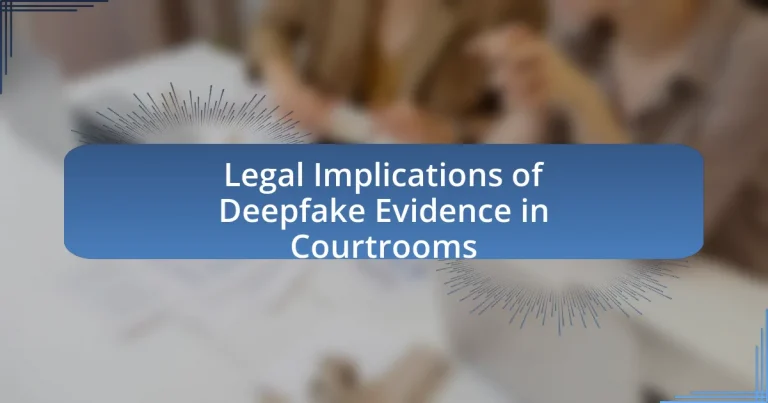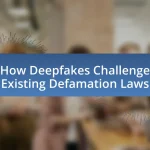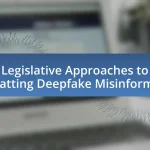The article examines the legal implications of deepfake evidence in courtrooms, focusing on challenges related to authenticity, admissibility, and the potential for misinformation. It highlights how deepfake technology can undermine the integrity of evidence, leading to wrongful convictions or acquittals, and discusses the evolving legal standards that govern the use of such evidence. Key considerations include the ethical dilemmas faced by legal professionals, the role of expert testimony, and the necessity for rigorous verification processes to ensure the reliability of deepfake content in legal proceedings. The article also addresses the psychological effects of deepfake evidence on jurors and the implications for future legal precedents.
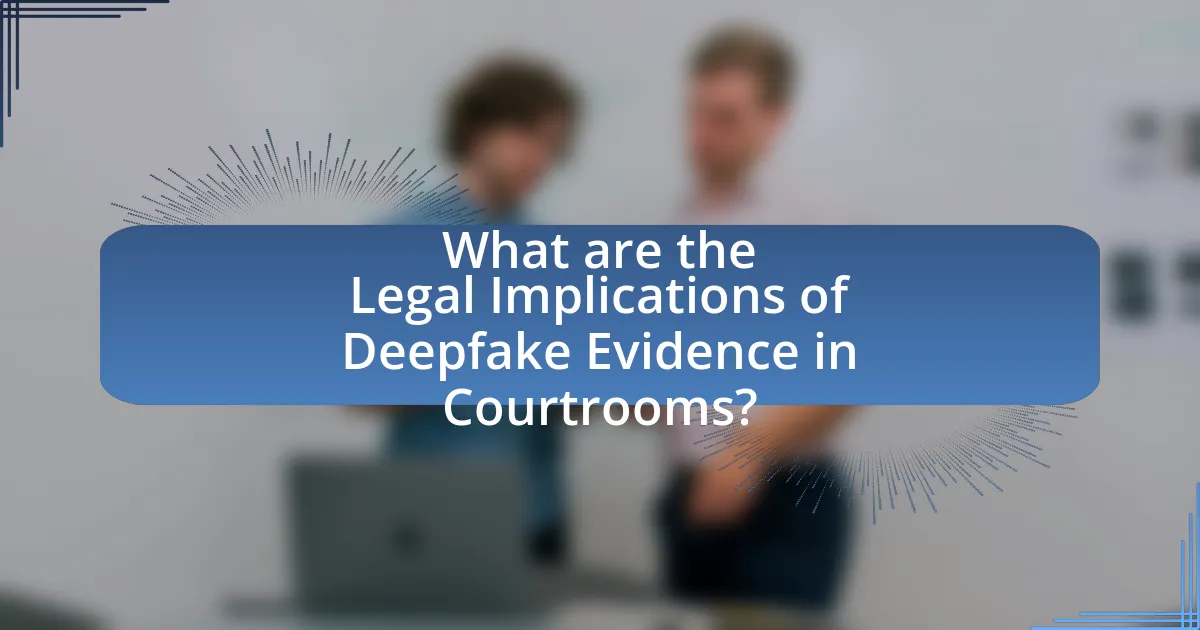
What are the Legal Implications of Deepfake Evidence in Courtrooms?
The legal implications of deepfake evidence in courtrooms include challenges related to authenticity, admissibility, and potential for misinformation. Courts must assess whether deepfake evidence can be verified as genuine, as the technology can create highly realistic but fabricated content. For instance, the Federal Rules of Evidence require that evidence must be relevant and reliable; thus, deepfakes may face scrutiny under these standards. Additionally, the use of deepfake evidence raises concerns about the potential for misleading juries, which could violate defendants’ rights to a fair trial. Legal precedents are still evolving, as seen in cases like United States v. McCoy, where the court emphasized the importance of expert testimony to establish the credibility of digital evidence.
How does deepfake technology impact the integrity of evidence?
Deepfake technology undermines the integrity of evidence by enabling the creation of highly realistic but fabricated audio and video content. This manipulation can lead to false representations of events, making it difficult for courts to ascertain the authenticity of evidence presented. For instance, a study by the University of California, Berkeley, found that deepfake detection methods struggle to keep pace with the rapid advancements in deepfake generation, highlighting the challenges in verifying evidence authenticity. As a result, the potential for deepfakes to mislead juries and influence legal outcomes poses significant risks to the judicial process.
What are the potential risks associated with using deepfake evidence?
The potential risks associated with using deepfake evidence include the undermining of trust in visual media, the potential for wrongful convictions, and the facilitation of misinformation. Deepfakes can create highly realistic but fabricated videos that may mislead juries and judges, leading to erroneous legal outcomes. For instance, a study by the University of California, Berkeley, found that deepfake technology can convincingly alter perceptions of reality, which poses significant challenges for the integrity of evidence in court. Additionally, the ease of creating deepfakes increases the likelihood of their use in malicious contexts, such as blackmail or defamation, further complicating legal proceedings.
How can deepfake evidence be manipulated in legal contexts?
Deepfake evidence can be manipulated in legal contexts through techniques such as altering audio and video content to misrepresent individuals’ actions or statements. This manipulation can involve sophisticated software that creates realistic but fabricated media, making it difficult for courts to discern authenticity. For instance, a study by the University of California, Berkeley, highlights that deepfake technology can produce videos that are nearly indistinguishable from real footage, complicating the verification process in legal proceedings. Additionally, the ease of access to deepfake creation tools allows individuals with malicious intent to produce misleading evidence, undermining the integrity of judicial outcomes.
What legal standards apply to the admissibility of deepfake evidence?
The legal standards for the admissibility of deepfake evidence primarily hinge on relevance, authenticity, and reliability. Courts typically assess whether the evidence is pertinent to the case and whether it can be authenticated, meaning that the party presenting the deepfake must demonstrate that it accurately represents the events or statements it purports to depict. The Federal Rules of Evidence, particularly Rule 901, require that evidence be authenticated before it can be admitted, which includes showing that the deepfake has not been altered in a misleading way. Additionally, courts may consider the potential for prejudice versus probative value under Rule 403, weighing whether the deepfake could mislead the jury or create unfair bias. These standards are crucial as they ensure that deepfake evidence is scrutinized for its integrity and reliability before being presented in legal proceedings.
What criteria do courts use to evaluate the authenticity of evidence?
Courts evaluate the authenticity of evidence using criteria such as relevance, reliability, and the chain of custody. Relevance ensures that the evidence directly pertains to the case, while reliability assesses the credibility of the source and the method of collection. The chain of custody verifies that the evidence has been preserved without tampering from the time of collection to presentation in court. These criteria are essential for establishing the integrity of the evidence, as demonstrated in cases where courts have excluded evidence due to failure to meet these standards, thereby underscoring their importance in legal proceedings.
How do existing laws address the challenges posed by deepfake technology?
Existing laws address the challenges posed by deepfake technology primarily through regulations related to fraud, defamation, and privacy. For instance, many jurisdictions apply existing fraud statutes to cases where deepfakes are used to deceive individuals or organizations, as seen in cases involving financial scams or identity theft. Additionally, defamation laws can be invoked when deepfakes harm an individual’s reputation by spreading false information, as demonstrated in legal actions taken against creators of malicious deepfake content. Privacy laws also come into play, particularly in instances where deepfakes exploit an individual’s likeness without consent, leading to potential legal repercussions under laws governing unauthorized use of personal images. These legal frameworks collectively aim to mitigate the risks associated with deepfake technology by providing avenues for redress and accountability.
What are the ethical considerations surrounding deepfake evidence?
The ethical considerations surrounding deepfake evidence include issues of authenticity, consent, and potential harm. Authenticity is a primary concern, as deepfakes can misrepresent individuals and events, leading to misinformation and erosion of trust in visual media. Consent is another critical factor; using someone’s likeness without permission raises ethical questions about privacy and autonomy. Additionally, deepfakes can cause significant harm, such as reputational damage or emotional distress, particularly when used maliciously in legal contexts. These considerations highlight the need for clear guidelines and ethical standards in the use of deepfake technology within legal proceedings.
How does the use of deepfake evidence affect the rights of defendants?
The use of deepfake evidence can significantly undermine the rights of defendants by introducing the potential for misleading or fabricated information to be presented in court. This technology allows for the creation of highly realistic but false representations of individuals, which can distort the truth and compromise the integrity of legal proceedings. For instance, a study by the University of California, Berkeley, highlights that deepfake videos can be indistinguishable from real footage, raising concerns about their admissibility and the risk of wrongful convictions. Consequently, the reliance on such evidence can violate a defendant’s right to a fair trial, as juries may be swayed by convincingly altered visuals that misrepresent reality.
What ethical dilemmas arise for legal professionals when dealing with deepfake evidence?
Legal professionals face significant ethical dilemmas when dealing with deepfake evidence, primarily concerning authenticity, integrity, and the potential for misleading the court. The challenge lies in determining the veracity of deepfake content, as it can be convincingly manipulated to misrepresent facts or events. This raises ethical questions about the duty of legal professionals to ensure that evidence presented is truthful and reliable, as mandated by legal standards.
Moreover, the use of deepfake evidence can lead to issues of consent and privacy, particularly if the individuals depicted did not authorize the use of their likeness. Legal professionals must navigate the balance between utilizing innovative technology and adhering to ethical obligations to protect individuals’ rights. The potential for deepfake evidence to undermine the justice system by creating false narratives further complicates the ethical landscape, as it can erode public trust in legal proceedings.
How can courts effectively handle deepfake evidence?
Courts can effectively handle deepfake evidence by implementing rigorous authentication processes and expert testimony to assess the validity of such evidence. Utilizing advanced forensic tools, courts can analyze the digital signatures and inconsistencies in deepfake videos or audio, which helps establish their authenticity. For instance, a study by the University of California, Berkeley, demonstrated that machine learning algorithms can detect deepfakes with over 90% accuracy, providing a reliable method for courts to evaluate evidence. Additionally, courts should establish clear guidelines for the admissibility of deepfake evidence, ensuring that it meets established legal standards for reliability and relevance.
What best practices should be established for evaluating deepfake evidence?
Best practices for evaluating deepfake evidence include implementing a multi-faceted verification process, utilizing advanced detection technologies, and establishing clear legal standards for admissibility. The verification process should involve cross-referencing the content with known authentic sources and assessing the context in which the evidence is presented. Advanced detection technologies, such as machine learning algorithms specifically designed to identify deepfake characteristics, can enhance accuracy in distinguishing real from manipulated media. Furthermore, legal standards should be developed to define the criteria for admissibility, ensuring that deepfake evidence is scrutinized for authenticity and relevance before being considered in court. These practices are essential to uphold the integrity of legal proceedings, as deepfakes can significantly impact the credibility of evidence and the outcomes of cases.
How can technology assist in verifying the authenticity of deepfake evidence?
Technology can assist in verifying the authenticity of deepfake evidence through advanced detection algorithms and forensic analysis tools. These technologies utilize machine learning and artificial intelligence to analyze video and audio content for inconsistencies, such as unnatural facial movements, irregular lighting, and audio mismatches. For instance, research conducted by the University of California, Berkeley, demonstrated that deepfake detection models can achieve over 90% accuracy in identifying manipulated media by examining pixel-level anomalies and temporal inconsistencies. Additionally, blockchain technology can provide a secure method for tracking the provenance of digital content, ensuring that any alterations are documented and verifiable.
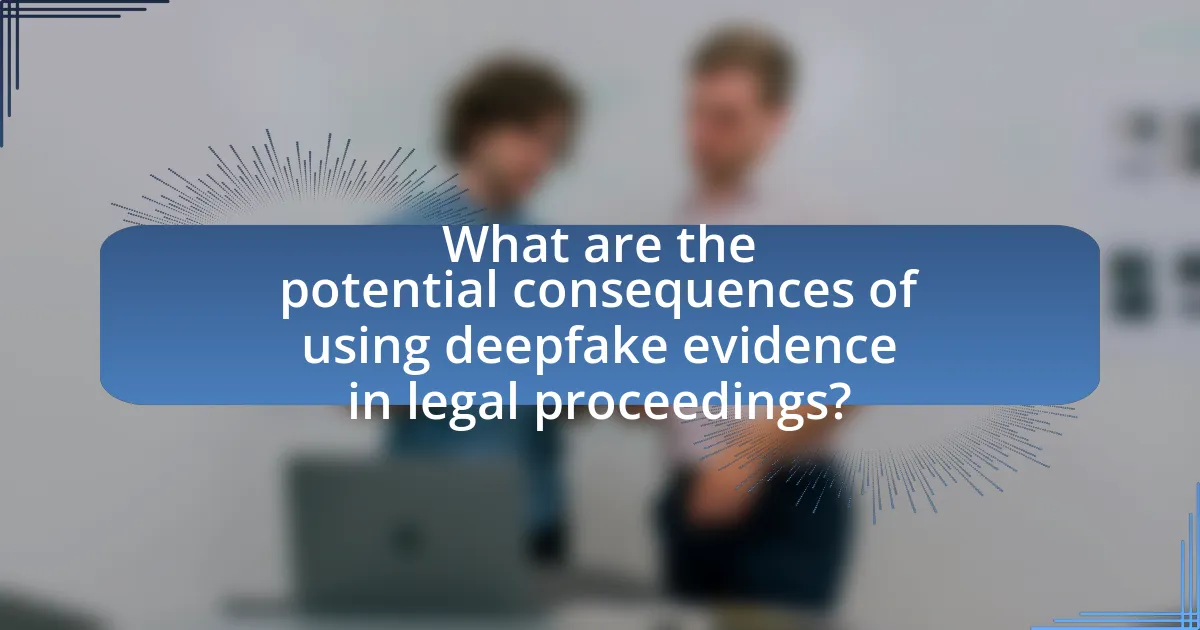
What are the potential consequences of using deepfake evidence in legal proceedings?
The potential consequences of using deepfake evidence in legal proceedings include undermining the integrity of the judicial system, leading to wrongful convictions or acquittals. Deepfakes can create realistic but false representations, making it difficult for juries and judges to discern truth from fabrication. For instance, a study by the University of California, Berkeley, found that deepfake technology can produce videos that are indistinguishable from real footage, raising concerns about the reliability of visual evidence in court. Additionally, the introduction of deepfake evidence may result in increased legal challenges regarding its admissibility, complicating the evidentiary process and potentially delaying trials.
How can deepfake evidence influence jury perceptions?
Deepfake evidence can significantly influence jury perceptions by creating a false sense of authenticity and credibility. Jurors may be swayed by the realistic nature of deepfakes, leading them to believe in the veracity of manipulated content, which can distort their judgment regarding the facts of a case. Research indicates that jurors exposed to deepfake videos are more likely to perceive the depicted events as genuine, even when informed about the potential for manipulation. A study published in the journal “Computers in Human Behavior” found that participants who viewed deepfake content were more likely to trust the information presented, highlighting the risk of deepfakes undermining the integrity of judicial proceedings.
What psychological effects might deepfake evidence have on jurors?
Deepfake evidence can significantly impact jurors’ psychological perceptions, leading to increased doubt about the authenticity of evidence presented in court. This skepticism may stem from the realization that visual and auditory information can be manipulated, causing jurors to question the reliability of all evidence, not just deepfakes. Research indicates that exposure to deepfake technology can induce feelings of confusion and mistrust, as jurors may struggle to discern truth from fabrication. A study published in the journal “Computers in Human Behavior” by authors including Hany Farid highlights that jurors exposed to deepfake evidence exhibited a higher tendency to doubt the credibility of witnesses and other forms of evidence, ultimately affecting their decision-making process.
How can deepfake evidence lead to wrongful convictions or acquittals?
Deepfake evidence can lead to wrongful convictions or acquittals by creating misleading representations that can be mistaken for authentic evidence. For instance, if a deepfake video falsely depicts an individual committing a crime, it may convince jurors of their guilt, resulting in a wrongful conviction. Conversely, if a deepfake is used to fabricate an alibi, it could lead to an acquittal of a guilty party. The potential for deepfakes to manipulate perceptions is underscored by a study from the University of California, Berkeley, which found that 96% of participants could not distinguish between real and deepfake videos, highlighting the risk of misinterpretation in legal contexts.
What are the implications for legal precedents regarding deepfake evidence?
The implications for legal precedents regarding deepfake evidence include challenges in establishing authenticity and reliability in court. As deepfakes can convincingly mimic real individuals, courts may face difficulties in determining the veracity of video and audio evidence, potentially leading to wrongful convictions or acquittals. For instance, the case of United States v. McGowan highlighted concerns over the admissibility of manipulated evidence, emphasizing the need for rigorous standards to assess digital content. Furthermore, existing legal frameworks may require updates to address the unique characteristics of deepfake technology, as traditional evidentiary rules may not adequately cover the complexities introduced by such synthetic media.
How might landmark cases shape future rulings on deepfake evidence?
Landmark cases can significantly influence future rulings on deepfake evidence by establishing legal precedents that define the admissibility and reliability of such evidence in court. For instance, cases like United States v. McGowan, which addressed the use of manipulated video evidence, set standards for evaluating authenticity and intent behind digital alterations. These precedents guide judges in assessing the probative value of deepfake evidence, potentially leading to stricter scrutiny and clearer guidelines for its use in legal proceedings. As courts reference these landmark decisions, they shape the evolving legal framework surrounding deepfakes, impacting how future cases are adjudicated and the standards of evidence required for conviction or acquittal.
What role do appellate courts play in addressing deepfake evidence issues?
Appellate courts play a crucial role in addressing deepfake evidence issues by reviewing lower court decisions regarding the admissibility and reliability of such evidence. These courts assess whether the lower courts properly applied legal standards and evidentiary rules when evaluating deepfake content, which can significantly impact the outcome of cases. For instance, appellate courts may establish precedents that clarify the legal thresholds for authenticity and relevance of deepfake evidence, thereby guiding future cases. This judicial scrutiny is essential, as deepfakes can mislead juries and undermine the integrity of the judicial process, necessitating careful examination of their use in legal proceedings.
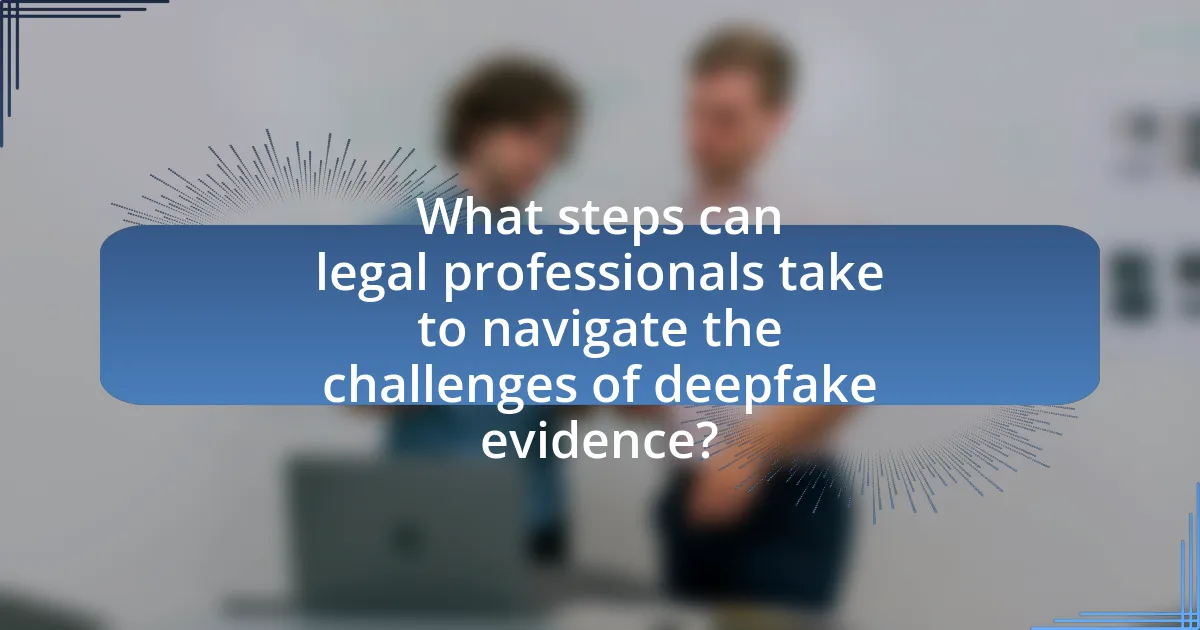
What steps can legal professionals take to navigate the challenges of deepfake evidence?
Legal professionals can navigate the challenges of deepfake evidence by implementing a multi-faceted approach that includes thorough verification, expert consultation, and legal education. Verification involves utilizing advanced forensic tools to analyze the authenticity of digital content, as studies indicate that deepfake detection technology has improved significantly, with some tools achieving over 90% accuracy in identifying manipulated media. Consulting with digital forensics experts can provide insights into the creation and detection of deepfakes, ensuring that legal arguments are grounded in technical realities. Additionally, ongoing legal education about the evolving landscape of digital evidence is crucial, as it equips legal professionals with the knowledge to address the implications of deepfakes in court effectively.
What training is necessary for legal professionals regarding deepfake technology?
Legal professionals require training in identifying, analyzing, and understanding the implications of deepfake technology. This training should encompass the technical aspects of deepfake creation and detection, legal standards for admissibility of digital evidence, and the ethical considerations surrounding the use of such technology in legal proceedings.
For instance, professionals should be familiar with forensic tools that can detect manipulated media, as well as the legal precedents that govern the use of digital evidence in court. Additionally, training should include awareness of the potential for deepfakes to impact witness credibility and jury perception, as highlighted in studies examining the influence of manipulated evidence on legal outcomes.
How can legal education incorporate deepfake evidence awareness?
Legal education can incorporate deepfake evidence awareness by integrating specific curriculum modules that focus on the identification, implications, and legal standards surrounding deepfake technology. These modules should include case studies that illustrate real-world instances where deepfake evidence has impacted legal outcomes, such as the 2020 case involving a deepfake video used in a political campaign, which raised questions about authenticity and intent. Additionally, legal education programs can collaborate with technology experts to provide practical training on recognizing deepfake content and understanding its potential to mislead juries and affect judicial processes. This approach ensures that future legal professionals are equipped with the necessary skills to navigate the complexities of deepfake evidence in courtrooms.
What resources are available for legal professionals to stay informed about deepfake developments?
Legal professionals can stay informed about deepfake developments through various resources, including academic journals, legal blogs, and specialized organizations. For instance, the Journal of Law and Cyber Warfare publishes research on emerging technologies, including deepfakes, while platforms like Lawfare and the Electronic Frontier Foundation provide timely updates and analyses on legal implications. Additionally, attending conferences such as the International Conference on Cyberlaw, Cybercrime, and Cybersecurity can offer insights from experts in the field. These resources ensure that legal professionals remain updated on the evolving landscape of deepfake technology and its implications for the law.
What strategies can be employed to mitigate risks associated with deepfake evidence?
To mitigate risks associated with deepfake evidence, implementing robust verification protocols is essential. These protocols can include the use of advanced detection technologies that analyze audio and visual inconsistencies in deepfake content. Research from the University of California, Berkeley, indicates that machine learning algorithms can effectively identify deepfakes with over 90% accuracy by examining pixel-level anomalies and inconsistencies in facial movements. Additionally, establishing legal frameworks that require the disclosure of the authenticity of digital evidence can enhance accountability and transparency in courtrooms. By combining technological solutions with regulatory measures, the integrity of evidence can be better safeguarded against the manipulation inherent in deepfakes.
How can legal teams prepare for the introduction of deepfake evidence in court?
Legal teams can prepare for the introduction of deepfake evidence in court by developing a comprehensive understanding of the technology and its implications for authenticity and reliability. This preparation includes training legal staff on identifying deepfake characteristics, collaborating with digital forensics experts to analyze the evidence, and establishing protocols for challenging the admissibility of such evidence based on its potential to mislead juries. Research indicates that deepfakes can significantly impact legal proceedings, as evidenced by a 2020 study published in the journal “Nature” which highlighted the increasing sophistication of deepfake technology and its potential to create realistic but false representations.
What role does expert testimony play in cases involving deepfake evidence?
Expert testimony plays a crucial role in cases involving deepfake evidence by providing specialized knowledge that helps the court understand the complexities of the technology. Experts can analyze the authenticity of deepfake content, assess its potential impact on the case, and explain the methods used to create or detect such evidence. For instance, a study published in the journal “Nature” by researchers at the University of California, Berkeley, demonstrated that expert analysis can identify deepfakes with over 90% accuracy, underscoring the importance of expert testimony in establishing the credibility of evidence in legal proceedings.
What are the best practices for presenting deepfake evidence in court?
The best practices for presenting deepfake evidence in court include ensuring the authenticity of the evidence, providing expert testimony on the technology used, and contextualizing the deepfake within the case. Authenticity can be established through forensic analysis that verifies the source and integrity of the deepfake, as demonstrated by studies showing that digital forensics can detect alterations in video content. Expert testimony is crucial, as professionals in digital media and forensic analysis can explain the creation and manipulation processes of deepfakes, which aids the court in understanding the evidence’s implications. Contextualization involves linking the deepfake to the specific claims or defenses in the case, ensuring that jurors grasp its relevance and potential impact on the case outcome.
How can attorneys effectively argue for or against the admissibility of deepfake evidence?
Attorneys can effectively argue for or against the admissibility of deepfake evidence by focusing on its authenticity, relevance, and potential for misleading the jury. To support admissibility, attorneys should present expert testimony on the technology behind deepfakes, demonstrating that the evidence is reliable and accurately represents the events in question. For instance, studies have shown that advanced deepfake detection tools can identify manipulated content with high accuracy, which can bolster the argument for its admissibility.
Conversely, to challenge admissibility, attorneys can emphasize the risks of deception inherent in deepfake technology, citing cases where deepfakes have been used to mislead audiences. They can reference the 2020 case of United States v. McGowan, where the court expressed concerns about the potential for deepfake evidence to confuse jurors and undermine the integrity of the judicial process. By leveraging these points, attorneys can construct compelling arguments regarding the admissibility of deepfake evidence in court.
What considerations should be made when presenting deepfake evidence to a jury?
When presenting deepfake evidence to a jury, it is crucial to establish the authenticity and reliability of the evidence. Jurors must understand the technology behind deepfakes, including how they are created and the potential for manipulation. For instance, expert testimony can clarify the methods used to generate the deepfake and the likelihood of it being altered. Additionally, the context in which the deepfake is presented should be examined, including its relevance to the case and the potential for misleading the jury. Research indicates that jurors may struggle to differentiate between real and manipulated content, emphasizing the need for clear explanations and visual aids to illustrate the differences. This approach helps ensure that jurors can make informed decisions based on the evidence presented.
